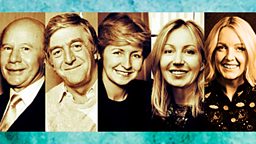Making of the Archive
Making of the Archive
It has long been an ambition of the Βι¶ΉΤΌΕΔ to make all the information about Desert Island Discs available online. From the outset, everything – information about the castaway and their choices and the programmes themselves - has been regarded as representing a snapshot of a particular person’s life and choices at the time of broadcast. Updating the information about castaways and their lives would have changed the nature of the material being published (as well as being a herculean and costly task). So what you read and hear needs to be considered within the context of the date of the original recording. For example many castaways have received honours, won prizes, developed their careers in new directions (and in some cases become Prime Minister) and many have since died.
Hunt the Data
Since 1942, there have been more than 2,800 editions of Desert Island Discs (and counting). Although castaways only started choosing books and luxuries regularly in the late 1950s, the scale of the data associated with the programme is huge. Collating all the music choices alone entailed having to find and bring together well over 22,000 individual pieces of information which had to be garnered from books, ancient paper files, a rusty and rudimentary database, defunct web production systems and – thankfully – current online systems. It was an amazing technical and logistical feat and the result was a master spreadsheet – which we called our ‘dirty spreadsheet’.
Clean-up
We called it ‘dirty’ because the next daunting task was to ‘clean’ all the data. This meant sorting out duplications, anomalies, filling in gaps and cross checking between dusty files and electronic systems. Much of the information had been written and collated at a time when today’s digital world was beyond imagination so was incomplete or sketchy. Archive copies of Radio Times and Roy Plomley’s book – Desert Island Lists – were constantly consulted. There were many discussions about correct spellings and pronunciations and a style-guide of sorts emerged – a combination of Radio 4’s online guide and best practice on the Radio 3 site. Finally, most of the classical music tracks were standardised in order to make the search facility work as well as is possible. Anomalies and inconsistencies however are bound to remain and the ‘clean-up’ will be an on-going task.
Design
With an archive of this size which already spans seven decades (and two centuries) one of the biggest challenges the website designers faced was creating a simple-to-use search. It was clear from the outset that to achieve this, some options would have to be limited. Search by castaway name, occupation, date of broadcast and programme presenter were prioritised with a free text search facility for music, book and luxury choices. Occupations and luxuries were all sorted into categories which led to much head-scratching and the occasional long and heated debate (how should Alison Steadman’s ‘hot lemon towels’, or ‘a box of plastic straws to fiddle with’ chosen by Stephen Poliakoff, be categorised?). How to describe Stephen Fry’s occupations?
Again the principle that what would be published was part of an archive led to decisions based on what was applicable at the time of broadcast.
Audio
Over 1500 Desert Island Discs programmes – dating back from the present day – are available permanently on this website, and are available on Βι¶ΉΤΌΕΔ Sounds. In a few cases, some of the speech inserts have been shortened, and in a very few cases, removed for rights reasons. The music in the podcasts is shorter than in the original broadcast for rights reasons and in a few cases removed, again for rights reasons. Inevitably tastes and times change and some of what is said needs to be considered in context. Where there is strong language, or disturbing imagery or particularly sensitive subjects referred to there are warnings on the relevant page or in the case of downloads, at the beginning of the audio.






